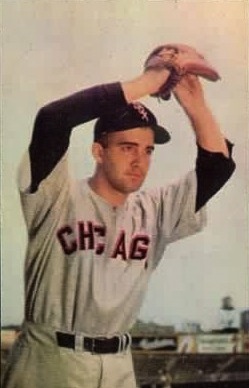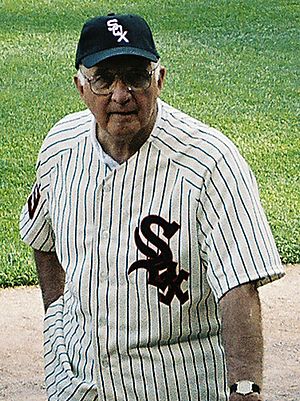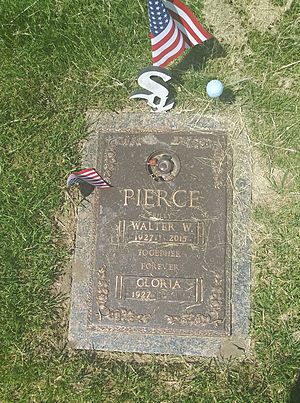Billy Pierce facts for kids
Quick facts for kids Billy Pierce |
|||
|---|---|---|---|

Pierce in 1953
|
|||
| Pitcher | |||
| Born: April 2, 1927 Detroit, Michigan, U.S. |
|||
| Died: July 31, 2015 (aged 88) Palos Heights, Illinois, U.S. |
|||
|
|||
| debut | |||
| June 1, 1945, for the Detroit Tigers | |||
| Last appearance | |||
| October 3, 1964, for the San Francisco Giants | |||
| MLB statistics | |||
| Win–loss record | 211–169 | ||
| Earned run average | 3.27 | ||
| Strikeouts | 1,999 | ||
| Teams | |||
|
|||
| Career highlights and awards | |||
|
|||
Walter William Pierce (April 2, 1927 – July 31, 2015), known as Billy Pierce, was an American pitcher in Major League Baseball (MLB). He played from 1945 to 1964. Most of his career was with the Chicago White Sox. He was their top pitcher from 1952 to 1961. During this time, the White Sox had the third-best record in MLB.
Billy Pierce was chosen for the All-Star team seven times. He led the American League (AL) in complete games three times. He also led the AL in wins, earned run average (ERA), and strikeouts once each. He pitched four one-hitters and seven two-hitters. On June 27, 1958, he almost pitched a perfect game. He was just one batter away!
After joining the San Francisco Giants in 1962, Pierce helped them win the National League (NL) pennant. He won all 12 of his home games that year. He also pitched a three-hit shutout in a playoff game. When he retired, his 1,999 strikeouts were the fifth most by a left-handed pitcher. The White Sox retired his number 19 in 1987. They also put up a statue of him in 2007.
Contents
Billy Pierce's Early Baseball Days
Growing Up Playing Baseball
Billy Pierce grew up in Highland Park, Michigan. He first became interested in baseball at age ten. He once said he agreed to have his tonsils removed if his parents gave him a real baseball and a good glove. He started as a first baseman but switched to pitching. He wanted to be like his hero, Detroit Tigers star Tommy Bridges.
Billy went to Highland Park Community High School. He pitched six shutouts in 1944. This earned him the nickname "Mr. Zero." He was the winning pitcher in a special All-American Boys' Game in New York. This game was held at the famous Polo Grounds. Connie Mack, a legendary manager, coached Pierce's team.
One reporter was amazed by his fastball. Pierce was very slender, weighing only 140 pounds. Richie Ashburn, a future Hall of Famer, played against him. Pierce was voted the game's best player. He won a four-year college scholarship. After thinking about studying medicine, he signed with the Detroit Tigers. He received a $15,000 bonus.
Playing in Major League Baseball
Starting with the Detroit Tigers
Billy Pierce joined the Tigers in 1945. He made the team before finishing high school. He hadn't even played in the minor leagues. He made his MLB debut in June 1945, just after his 18th birthday. He pitched in a few games as a relief pitcher. He was on the Tigers' roster when they won the 1945 World Series.
In 1946, Pierce played for the Buffalo Bisons. He missed most of the year with a back injury. He returned to Detroit in 1948. He mostly pitched from the bullpen. He made five starts and had a 3–0 record. He was still very light, weighing only 148 pounds.
On August 8, he got his first MLB win. He pitched well against the Washington Senators. However, he walked many batters that year. The Tigers traded him to the White Sox in November. This trade is often seen as one of the most one-sided in baseball history. The Tigers even tried to get him back, offering more money.
Becoming a Star with the Chicago White Sox
When Pierce first joined the White Sox, he still struggled with control. In 1950, he walked 137 batters. But he also showed signs of how great he would become. On May 29, 1949, he pitched against Negro league legend Satchel Paige. It was a close game that went into the 11th inning.
On June 15, 1950, Pierce pitched his first career shutout. It was a 5–0 one-hitter against the Yankees. The only hit was a single in the fifth inning.
Developing His Pitching Style
For 13 seasons, Pierce was the White Sox's best pitcher. He led the team in wins nine times. He also led in strikeouts eight times. He was the team's Opening Day starter seven times. He had a great fastball and an excellent curveball. In 1951, he added a slider. He also had a changeup.
He pitched quickly with an over-the-top motion. This was similar to Sandy Koufax later on. In 1951, his ERA was 3.03, fourth best in the league. In 1952, his ERA was 2.57. On September 21, 1952, he broke a team record. He had 144 strikeouts, the most by a left-hander.
On April 16, 1953, Pierce pitched his second one-hitter. He allowed only one hit, a double, in a 1–0 win. He was chosen to start the All-Star Game for the AL. This was the first time a White Sox pitcher had done this. He allowed only one hit in three innings. Ted Williams, a Red Sox star, praised Pierce's pitching.
Challenges and Successes
In the early 1950s, Pierce often pitched against strong teams. This included the powerful Yankees and Indians. He might have won more games if he had faced all teams equally. On August 3, 1953, he started a streak of 39 2/3 scoreless innings. This was one of the longest streaks in AL history. It ended on August 19. He led the league in strikeouts (186) and was second in ERA (2.72). He also had seven shutouts that season.
Pierce's 1954 season was interrupted by arm pain. It was caused by an infected wisdom tooth. He had surgery and missed time. He slowly returned to form. He pitched two consecutive 3–0 shutouts in July. Even with only nine wins, he was one of few pitchers to beat the Indians three times. They won a league-record 111 games that year.
Pierce was also a good baserunner. He was used as a pinch runner 30 times. He even scored for Minnie Miñoso, a great base stealer.
Peak Performance Years
In 1955, Pierce started the All-Star Game again. He had a 2.11 ERA before the break. He ended the season leading the league in ERA with 1.97. This was the lowest ERA in MLB between 1946 and 1963. He was rated as the best pitcher in MLB that year.
In 1956, he started his third All-Star Game. He won 20 games that year. He was the first White Sox pitcher since 1941 to do so. He also had a career-high 192 strikeouts. He was named AL Pitcher of the Year. In 1957, he won 20 games again. This made him the first White Sox pitcher since 1922 to have back-to-back 20-win seasons.
Pierce was very popular with White Sox fans. A poll of sportswriters named him the most popular player in 1957. He was also named the team's best fielding pitcher.
Nearing a Perfect Game
In 1958, Pierce was second in the league in wins (17) and ERA (2.68). On June 27, he pitched his greatest game. He retired the first 26 batters against the Senators. He was one out away from a perfect game. But Ed Fitz Gerald hit a double. Pierce then struck out the next batter to end the game. No left-hander had pitched a perfect game since 1880.
Pierce was disappointed but praised his teammates. Vice President Richard Nixon told Pierce he watched the game. Pierce later said he wished he had gotten the perfect game. His streak of 33 scoreless innings ended on July 1.
Pierce led the league in complete games from 1956 to 1958. He was an All-Star again in 1957, 1958, 1959, and 1961. On June 11, 1959, he pitched his fourth one-hitter. The White Sox won the AL pennant in 1959. This was their first pennant in 40 years.
Manager Al López decided not to start Pierce in the 1959 World Series. This was a very controversial decision. Pierce pitched in relief in the last three games. He allowed only two hits and no runs in four innings. He was disappointed not to start.
Offensive Support Challenges
The "Go-Go White Sox" teams of the 1950s relied on speed, defense, and pitching. They didn't score many runs. Pierce often struggled for offensive support. The team averaged fewer runs in his starts. In over two-thirds of his losses, the White Sox scored two runs or less.
When the White Sox scored four or more runs, Pierce was very successful. He had a record of 99–10 when they scored five or more runs. This shows how important run support was for him.
Rivalry with the Yankees
Pierce played a big role in the White Sox's rivalry with the powerful Yankees. He often faced Whitey Ford, the Yankees' star left-hander. They pitched against each other 15 times. Pierce had a 21–21 record against the Yankees from 1952 to 1960.
Many people thought Pierce was as good as Ford. But Ford had a much stronger offense behind him. Shirley Povich of The Washington Post called Pierce the league's top left-hander. On July 28, 1959, Pierce's win over the Yankees put the White Sox in first place. They stayed there and won the pennant.
Yankees players like Hank Bauer and Tommy Byrne said Pierce was tough to hit. Sportswriter Bill Madden admired how Pierce dueled Ford despite the odds. The Yankees even tried to trade for Pierce in the early 1950s.
Later Career and Retirement
Joining the San Francisco Giants
In his last two seasons with Chicago, Pierce had records of 14–7 and 10–9. On June 20, 1961, he broke Ed Walsh's White Sox record for career strikeouts. On November 30, 1961, he was traded to the San Francisco Giants. The Giants had a powerful offense with players like Willie Mays.
Pierce took advantage of the improved run support. He won his first eight starts with the Giants. On April 13, his first start was very rewarding. He allowed only two hits in 7 1/3 innings. The crowd gave him a huge ovation.
On June 14, he was accidentally spiked in the ankle. This injury required 14 stitches. It likely cost him another All-Star selection. He returned to pitch later in the season. He won all 11 of his home starts at Candlestick Park. The Giants tied the Dodgers for the NL pennant.
Pierce started the first playoff game against the Dodgers. He pitched a three-hit 8–0 victory. This pushed his Candlestick record to 12–0. He called it "the most satisfying game I ever pitched." He also pitched in Game 3 to clinch the pennant. In the 1962 World Series against the Yankees, he started Game 3. He pitched well but took a 3–2 loss. He pitched another great game in Game 6, winning 5–2.
Final Seasons
Pierce started the Giants' home opener in 1963. He pitched the last shutout of his career. He gradually moved to the bullpen in 1963 and 1964. On September 10, 1964, he made his last career start. He pitched 7 2/3 innings and got a 5–1 win. He made one more appearance in relief on October 3. He retired the next day.
In his 18-season career, Pierce had a 211–169 record. His ERA was 3.27. He completed 193 of his 432 starts. He had 38 shutouts and 32 saves. His 186 wins with the White Sox rank fourth all-time.
Pierce was 5 feet 10 inches tall and weighed 160 pounds. He was one of the smaller pitchers to have such great success. His catcher, Sherm Lollar, said he had "wonderful coordination." Pierce was also very durable. He was one of the few pitchers under 6 feet tall to lead the league in complete games multiple times. He was the last pitcher to lead the AL in complete games three years in a row.
Billy Pierce's Career Highlights
Key Statistics
| Years | Games | Wins | Losses | Win % | ERA | Complete Games | Shutouts | Saves | Innings Pitched | Strikeouts |
| 18 | 585 | 211 | 169 | .555 | 3.27 | 193 | 38 | 33 | 3306.2 | 1999 |
Awards and Achievements
- All-Star: 1953, 1955, 1956, 1957, 1958, 1959, 1961
- American League leader in ERA (1955)
- American League leader in wins (1957)
- American League leader in complete games (1956–1958)
- American League leader in strikeouts (1953)
- World Series champion (1945)
- Pitched 20 wins in a season (twice)
- Pitched four one-hitters
- Pitched seven two-hitters
- Member of the Chicago White Sox All-Century Team (2000)
Life After Baseball
 |
|
| Billy Pierce's number 19 was retired by the Chicago White Sox in 1987. |

After retiring from baseball, Billy Pierce did not become a coach. He worked in various jobs, including as a stockbroker. From 1974 to 1997, he worked in sales and public relations. He also worked as a White Sox scout. He discovered Ron Kittle, who won Rookie of the Year in 1983.
The White Sox retired his number 19 in 1987. He is one of only eight players to receive this honor. In 2000, he was named to the Sox Team of the Century. He was inducted into the Michigan Sports Hall of Fame in 2003. On October 4, 2005, Pierce threw out the first pitch before a White Sox playoff game. The White Sox went on to win the 2005 World Series.
On July 23, 2007, the White Sox unveiled a statue of Pierce. It is located at U.S. Cellular Field. He was excited for his grandkids to see it. He also co-authored a book called "Then Ozzie Said to Harold...": The Best Chicago White Sox Stories Ever Told.
Billy Pierce married Gloria McCreadie in 1949. They had three children. He remained involved with the White Sox community. He also led the Chicago Baseball Cancer Charities. He started supporting this cause after his teammate Nellie Fox died from cancer. On June 29, 2013, the White Sox gave out statuettes of Pierce to fans. Billy Pierce passed away on July 31, 2015, at age 88. He died from gallbladder cancer.
Hall of Fame Consideration
Billy Pierce has not been elected to the National Baseball Hall of Fame. He was on the ballot for five years (1970–1974). He never received enough votes. In 2014, he was chosen as a candidate for the Golden Era Committee ballot. He was considered for induction in 2015 but fell short. In 2021, he was again on the Golden Days Era ballot for the Class of 2022. However, he did not receive enough votes for selection.
See also
- List of Major League Baseball career strikeout leaders
- List of Major League Baseball career wins leaders
- List of Major League Baseball annual wins leaders
- List of Major League Baseball annual ERA leaders
- List of Major League Baseball annual strikeout leaders



